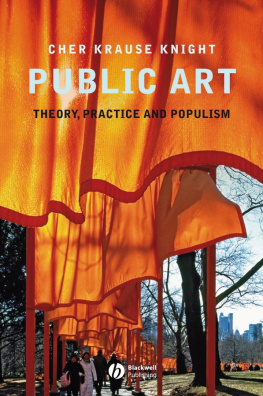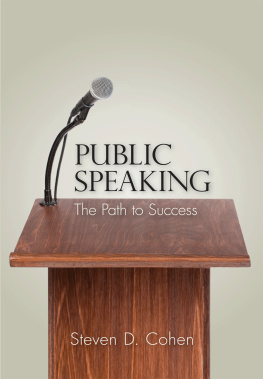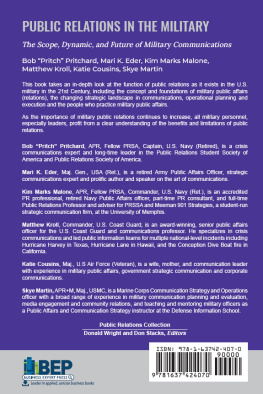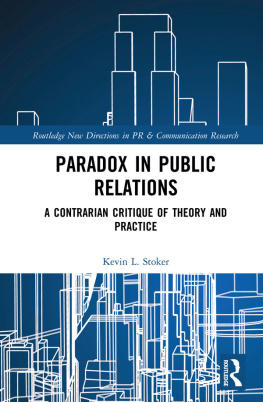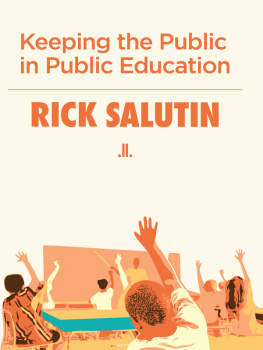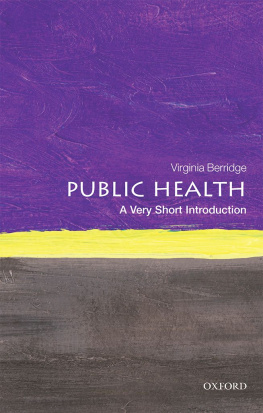
For Beatrix Marcel
I love you the whole world.
Public Art
Theory, Practice and Populism
Cher Krause Knight
2008 Cher Krause Knight
BLACKWELL PUBLISHING
350 Main Street, Malden, MA 02148-5020, USA
9600 Garsington Road, Oxford OX4 2DQ, UK
550 Swanston Street, Carlton, Victoria 3053, Australia
The right of Cher Krause Knight to be identified as the author of this work has been asserted in accordance with the UK Copyright, Designs, and Patents Act 1988.
All rights reserved. No part of this publication may be reproduced, stored in a retrieval system, or transmitted, in any form or by any means, electronic, mechanical, photocopying, recording or otherwise, except as permitted by the UK Copyright, Designs, and Patents Act 1988, without the prior permission of the publisher.
Designations used by companies to distinguish their products are often claimed as trademarks. All brand names and product names used in this book are trade names, service marks, trademarks, or registered trademarks of their respective owners. The publisher is not associated with any product or vendor mentioned in this book.
This publication is designed to provide accurate and authoritative information in regard to the subject matter covered. It is sold on the understanding that the publisher is not engaged in rendering professional services. If professional advice or other expert assistance is required, the services of a competent professional should be sought.
First published 2008 by Blackwell Publishing Ltd
Library of Congress Cataloging-in-Publication Data is available for this book
ISBN 978-1-4051-5558-8 (hardback)
ISBN 978-1-4051-5559-5 (paperback)
A catalogue record for this title is available from the British Library.
The publishers policy is to use permanent paper from mills that operate a sustainable forestry policy, and which has been manufactured from pulp processed using acid-free and elementary chlorine-free practices. Furthermore, the publisher ensures that the text paper and cover board used have met acceptable environmental accreditation standards.
For further information on
Blackwell Publishing, visit our website at
www.blackwellpublishing.com
Preface
The role of the spectator is to determine the weight of the work on the esthetic scale. (Duchamp 1957: 819)
I cannot think of a single book on public art that commences with Marcel Duchamp. Maybe this is not surprising. Duchamp, the irreverent artist-provocateur, is best known as a Dadaist. Confounded by the massive violence of World War I, the Dada artists responded to senseless cruelty and destruction with artworks that trafficked in absurdity, mocking conventional art world pretensions. Dadaism was a social movement as much as an artistic one; the aforementioned esthetic scale actually encompassed much more than aesthetics. Audiences were asked to interrogate the foundations of society, moving beyond collective and individual comfort zones. Dadaism represented an unwillingness to accept things as they are, resisting complicit endorsement of the status quo. Spectators bore a great responsibility if not to change their behaviors, at least to question the social norms that formed them. Duchamp instinctively apprehended the viewers primary role in the art experience. In The Creative Act (1957), he scrutinizes the authority of the artist, and affirms the power of the spectator. He describes the art coefficient as a gap between an artists intention and the artworks realization, where viewers actively engage with and interpret the art. Duchamp proposes that an artist cannot fully express his own intent, so the viewer must complete the Creative Act; without someone to react to and interact with the art, the artistic process is forever unfinished, a still-born idea never seizing its absolute potential. No longer a passive act, viewing gives way to a multitude of readings, limited only by the number of people in a works audience. Duchamp offered a potent analogy, describing art in its raw state as molasses, which is then refined into pure sugar by its spectators (1957: 81819). The artist provides the source material, but it is the viewer with her own viewpoint, taste, education, and experience who discerns its meaning and relevance. Once art is shared with a larger public, the artist surrenders control to the unpredictable will and whims of the people.
In the glossary of New-Land-Marks public art is defined as art placed in public places and spaces, and those spaces as open to everyone to use and enjoy (Bach 2001: 153). If only it were that easy! The contours of arts publicness are continually assessed on its physical location. But as Hilde Hein asserts, The sheer presence of art out-of-doors or in a bus terminal or a hotel reception area does not automatically make that art public no more than placing a tiger in a barnyard would make it a domestic animal (1996: 4). I suggest we can best understand arts public functions when we consider the interrelationship between content and audience; what art has to say, to whom it speaks, and the multiple messages it may convey. This approach prompts several questions: Is public arts responsibility to communicate with the public? To do so, must it transcend an artists private or aesthetic concerns, and generate human reaction from a larger audience (Doezema 1977: 9, 14)? If so, how big must that audience be? As early as 1903 Charles Mulford Robinsons Modern Civic Art called for art that was comprehensible and socially relevant to its audiences, addressing the conditions before their very eyes (1903: 34). But the notion of a shared artistic vocabulary has long since dissipated; as Arlene Raven contends, public art isnt a hero on a horse any more (1989: 1). Through his experiences as a public art administrator Jerry Allen observed that the civic symbolism of the past was a language in which the public was no longer fluent. He queries: Can substantially fewer than everybody be the audience for public art without destroying the public character of the art? Allen concludes that since public art is broad and heterogeneous, speaking to wide though not necessarily large and generalized audiences, it would be best to define a new public for each work (1985: 2467, 2501). For Patricia Phillips art only becomes fully public when it takes the idea of public as the genesis and subject for analysis: it is public because of the kinds of questions it chooses to ask or address, and not because of its accessibility or volume of viewers (1992: 298). To this I would add that arts publicness rests in the quality and impact of its exchanges with audiences. These do not hinge on wide acceptance, but on the arts ability to extend reasonable and fair opportunities for members of the public to understand and negotiate their own relationships with it. I propose to conceive public art primarily through this populist agenda.
A few words must be said about the frictions perceived and actual between art elitists and populists, although caution must be exercised when dealing in such binaries. Generally, elitists emphasize the need for professionalism and formal education in the arts, art-specific institutions, and standards of quality according to established canons of taste. For them the boundaries of culture are fixed though fragile; they are perceived as centurions standing guard over and imposing their culture on others. Conversely, populists usually argue for the widest possible availability of art experiences, welcome cultural diversity, and promote public (often amateur) participation in and experiential relationships to art. Their pluralistic construction of artistic merit, open-ended definitions of taste, and insistence on arts subjectivity and m utability prompt elitists to charge them with eroding cultures quality and substance. These conflicting agendas result in what Margaret Wyszomirski identified as the tension between the quest for excellence and the quest of equality. She concludes that these quests might coalesce in a framework of cultural democracy, if we temper the notion of elite art audiences with open-door exclusivity (1982: 1314, 17; Levine 1988: 255). I interpret this as an egalitarian impulse; to provide all interested parties with an entre into the arts that nurtures confidence in their own critical faculties, but allows final decisions about engagement to rest with each individual. Yet such agency can be hampered by what Miwon Kwon identifies as arts great myth: the presumption that it is good and everybody wants it (Arning, Chin, Jacob, and Kwon 2006).
Next page
